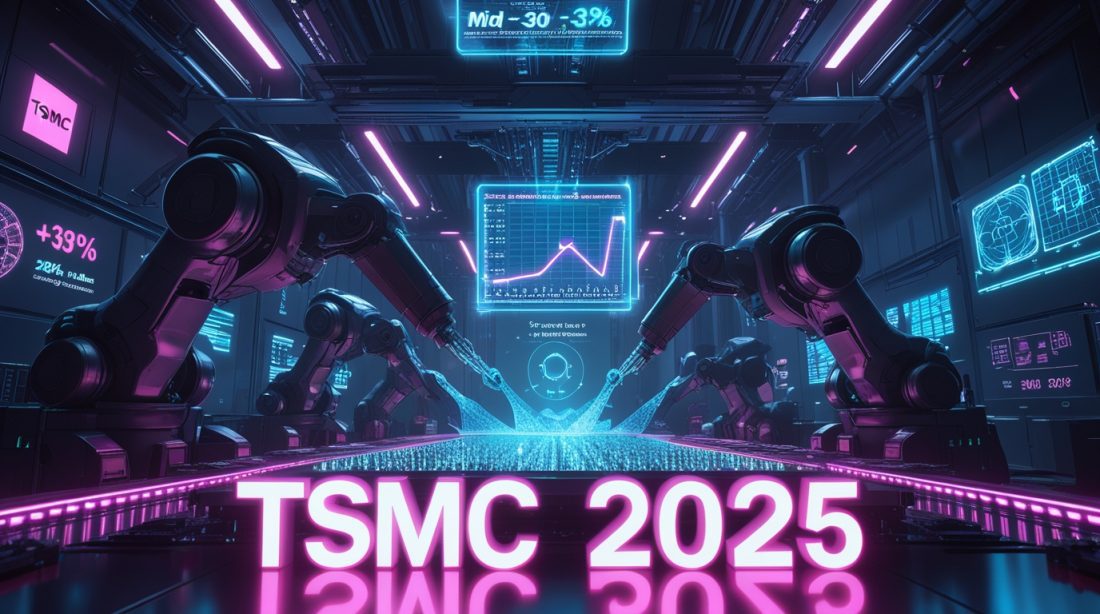In the relentless surge of the AI revolution, the most confident voice belongs to the company building its foundation, one chip at a time.
Taiwan Semiconductor Manufacturing Company (TSMC) has once again lifted its financial targets, with the TSMC 2025 revenue forecast now projecting annual growth in the “mid-30%” range—a notable increase from its previous estimate of “around 30%” made just three months prior. This upward revision indicates that the artificial intelligence boom is not only sustaining its momentum but also accelerating, as confirmed in MSN’s coverage of the TSMC 2025 revenue forecast, which highlights CEO C.C. Wei’s bullish stance on AI demand.
The adjustment is a direct response to what CEO C.C. Wei describes as AI demand that “continues to be very strong — more strong than we thought three months ago.” The company’s conviction in what it calls the “AI megatrend” is strengthening, driven by powerful signals from customers scrambling for capacity to support their businesses.
TSMC 2025 Revenue Forecast: The Numbers Behind a Record-Shattering Quarter
TSMC’s revised outlook is grounded in a robust third quarter. The company posted a net income of NT$452.3 billion (approximately $14.8 billion), a staggering 39.1% increase from the same period last year. Revenue for the quarter hit NT$989.92 billion, rising 30.3% year-over-year and handily beating market expectations. A result that Investing.com attributes to the explosive demand for AI chips and data center acceleration.
The company’s profitability also impressed, with its gross margin climbing to 59.5%, a level that underscores its pricing power and operational efficiency in producing the world’s most advanced semiconductors.
Here’s a breakdown of TSMC’s stellar Q3 2025 financial performance:
| Financial Metric | Value | Year-over-Year Change | Performance vs. Expectations |
|---|---|---|---|
| Revenue | NT$989.92 billion | +30.3% | Beat estimates |
| Net Income | NT$452.3 billion | +39.1% | Beat estimates |
| Gross Margin | 59.5% | Improved from 58.6% previous quarter | Above analyst projections |
| 2025 Revenue Growth Forecast | Mid-30% range (in USD) | Second upward revision this year | Surpassing prior “around 30%” forecast |
Why TSMC Is Bullish on AI: The Core Drivers of Demand
The “Why” Behind the Chip Shortage
The simple answer is that everyone needs AI chips, and TSMC is the only company that can manufacture them at the required scale and sophistication. Its high-performance computing (HPC) division, which encompasses AI and 5G applications, is now the company’s undisputed growth engine, making up 57% of total sales in the third quarter. This marks a significant industry shift, as HPC has clearly eclipsed smartphones (30% of revenue) as TSMC’s primary business.
This demand is materializing through massive, long-term commitments from the biggest names in tech. AI firms like OpenAI are securing deals for gigawatts of computing power, relying on chips produced by TSMC’s clients — Nvidia, AMD, and Broadcom. These partnerships represent a fundamental bet on the future of AI infrastructure, echoing the rapid expansion seen in areas like AI-driven crypto trading platforms and decentralized revenue models that rely on high-speed, low-latency computing power.
Capacity, Capital, and Cutting-Edge Technology
To keep up, TSMC is not just spending money — it’s strategically investing for the long term. The company raised the floor of its 2025 capital expenditure plan to $40 billion, up from $38 billion, with the total range now set at $40–42 billion. A significant portion of this investment is funneled into the most advanced technologies.
- Advanced Process Leadership: Chips with transistor sizes of 7-nanometer or smaller accounted for a massive 74% of TSMC’s total wafer revenue. The latest 3nm process alone contributed 23% of revenue, with 5nm adding another 37%.
- The Next Frontier: TSMC remains on track to begin mass production of its 2nm process later this quarter, with Gadgets360 reporting that Apple is expected to claim nearly half of the initial 2nm output. CEO C.C. Wei noted it is expected to “enter volume production with excellent yields.” This will be followed by the even more advanced A16 technology in the second half of 2026.
- A Global Footprint: The company is “accelerating the pace of capacity expansion in Arizona” and is poised to acquire a second large plot of land to support a standalone mega-fab complex in the US. Expansions in Japan and Germany are also progressing smoothly, building a more resilient global supply chain — a trend mirrored across other sectors where industrial AI innovation is driving massive investment cycles.
An Industrial Analyst’s View: Beyond the Hype
From an industrial perspective, TSMC’s forecast is a robust indicator of tangible, long-term investment in AI — not short-term speculation. The company is in a unique position, seeing orders not just from its direct customers like Nvidia and Apple, but also feeling the “very strong signals” from their customers down the chain.
This multi-layered demand gives TSMC unparalleled visibility. As CEO C.C. Wei stated, “We are still very comfortable that the demand on leading-edge semiconductors is real.” The company acknowledges geopolitical uncertainties and the loss of parts of the Chinese market but argues that the sheer force of AI demand is more than enough to compensate.
The rapid expansion of AI applications — from predictive analytics to crypto automation — highlights the same megatrend identified in AI-driven financial markets, where intelligent automation is now reshaping revenue streams at scale.
The Road Ahead
TSMC’s upgraded forecast is more than a financial adjustment; it’s a barometer for the global technology industry. The AI-driven demand for advanced semiconductors is stronger and more durable than many anticipated, fueling a record-breaking investment cycle with TSMC squarely at the center. As the company gears up for its next wave of 2nm and A16 technology, its role as the bedrock of the AI ecosystem is only set to solidify.
TL;DR: TSMC, the world’s largest chipmaker, has raised its 2025 revenue forecast for the second time this year, now predicting mid-30% growth. This move, fueled by stronger-than-expected AI chip demand, follows a record third quarter where profit jumped 39%. The company is boosting capital spending to at least $40 billion to expand capacity for advanced technologies like its 2nm process.


